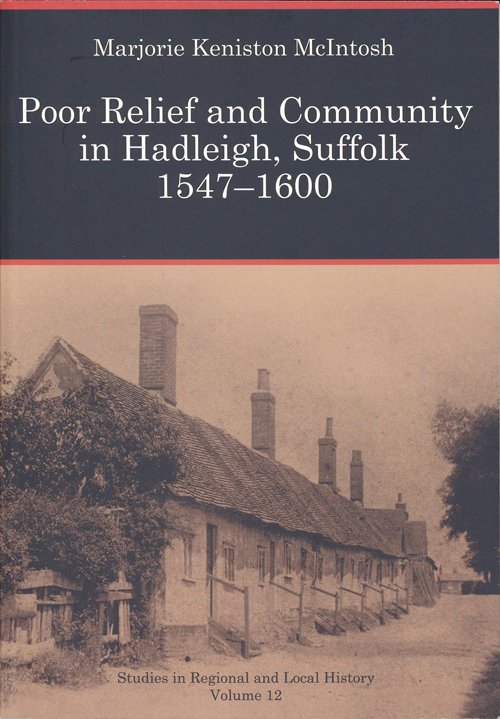Poor Relief and Community in Hadleigh, Suffolk 1547-1600
Review

Poor Relief and Community in Hadleigh, Suffolk 1547-1600: volume 12 Studies in Regional and Local History, Marjorie Keniston McIntosh, University of Hertfordshire Press, 2013, hardback, 188p, 31 tables, 4 figures, ISBN 978-1-907396-91-5, £35.00. [paperback version to follow later in the year]
‘The poor always ye have with you,' we are reminded by St John's Gospel (ch. 12, v. 8) in the Authorised Version of 1611. A rising population during the 16th century brought increasing problems of poverty and concerns about the threat posed to public order. A series of Poor Law Acts, now collectively labelled by historians the ‘Old Poor Law', were the response. These Acts put parishes firmly in charge of poor relief, conferring the power to raise a rate for the purpose and appoint Overseers of the Poor. It is this formative period in the history of poor relief on which Professor McIntosh focuses in her detailed case study of late-Tudor/Elizabethan Hadleigh, a prosperous small cloth-manufacturing town in Suffolk, with a population hovering around 3,000.
Hadleigh developed a finely-tuned, sophisticated system of poor relief that was far from typical of the period and for which exceptionally detailed accounts survive, notably in the Hadleigh Archive. Professor McIntosh sets the scene with descriptions of the local economy, town government, and religious influences (a ‘peculiar' directly responsible to the Archbishop of Canterbury and robustly Protestant at the time of the Reformation) before turning her attention to the recipients of poor relief. Analyses by age, sex, and marital status are fleshed out by details of household units, family relationships and the amount, type and duration of assistance received. Hadleigh's unemployed, elderly - there were two sets of almshouses - and those with disabilities all receive attention.
In order to qualify for help, one needed to be seen as ‘deserving' (abuses were reported and punished) and to ‘belong'. Settlement in the parish conferred the right to relief. Active neighbourhood supervision identified incomers and steps were taken to prevent those who might need relief in the future from settling in the town. This was no place for ‘welfare tourism'. A particularly interesting chapter explores the range of targeted interventions, short and long-term, deployed to assist poor children: financial; in kind; boarding with other families; discipline and occupational training in a residential institution (effectively a workhouse); and placing in work.
A final chapter poses a key question. Why did Hadleigh develop such an elaborate system of poor relief? The town's prosperity, based on cloth manufacture, provided the resources but similar conditions elsewhere did not produce the same results. The influence of Hadleigh's Protestant clerics is identified as a prime motive force (surviving wills of the period demonstrate a strong Protestant bias), along with the needs of local clothiers to maintain a workforce, and a town administration of dubious legal status. Hadleigh was run by a group of self-appointed ‘Chief Inhabitants'. Professor McIntosh suggests:
"... concern for the poor and operating an efficient system of relief probably served as a unifying element [that] reinforced civic identity while granting moral and practical legitimacy to its leaders."
A comprehensive and absorbing study.

